Chewy’s Stock Plunges After Q2 2025 Earnings: Wall Street’s High Hopes Deflated
Chewy, Inc. (NYSE: CHWY), the online pet supplies retailer, saw its stock tumble up to 15.89% on September 10, 2025, following its second-quarter earnings release for the period ending August 3, 2025. Despite beating revenue expectations, the market’s lofty pre-earnings optimism, fueled by a 16.6% stock rally over the past month, set a bar the company couldn’t fully clear, leading to a sharp sell-off.
Earnings Highlights and Market Reaction
Chewy reported Q2 2025 net sales of $3.10 billion, up 8.6% year-over-year, surpassing the FactSet consensus of $3.08 billion and the company’s own guidance of $3.06-$3.09 billion. Adjusted earnings per share (EPS) hit $0.33, aligning with analyst estimates but falling short of the higher expectations some, like Mizuho, had anticipated after upgrading the stock to outperform.
However, GAAP net income dropped to $62 million from $299.4 million a year ago, largely due to a one-time $253 million tax credit in Q2 2024 that inflated prior results. This led to a GAAP EPS of $0.14, down 80% year-over-year, disappointing investors expecting sustained profitability. The stock fell to $35.41 in intraday trading, down from a previous close of $42.10, as seen in the finance card above.
Key growth drivers included a 14.9% surge in Autoship sales to $2.58 billion, accounting for a record 83% of total sales, and a 4.5% rise in active customers to 20.9 million. Gross margin improved by 90 basis points to 30.4%, and adjusted EBITDA rose 26.5% to $183.3 million, reflecting operational strength. Yet, the market fixated on the net income drop and margin pressures from the Chewy+ membership program, which, while boosting sales frequency, operates at lower profitability.
Why the Drop? Wall Street’s Overzealous Expectations
Wall Street’s pre-earnings enthusiasm, sparked by Mizuho’s upgrade and expectations of a “strong print,” set an unrealistic benchmark. Chewy’s stock had outperformed the S&P 500’s 1.9% gain over the past month, climbing 16.6%, which amplified the fallout when results merely met, not exceeded, forecasts. The finance card above shows a 14.3% plunge, steeper than the historical average earnings-day move of 10.1%, signaling an overreaction.
Analysts like those at The Motley Fool argue the stock’s high valuation—32 times free cash flow and nearly 100 times trailing earnings—made it vulnerable to any shortfall. CEO Sumit Singh noted on the earnings call that Chewy+ sales, while promising (3% of total sales in July, aiming for mid-single digits by year-end), come at lower margins, spooking investors focused on profitability.
Company Outlook and Strategic Moves
Chewy raised its fiscal 2025 sales guidance to $12.5-$12.6 billion from $12.3-$12.45 billion, slightly above the consensus of $12.58 billion, with an adjusted EBITDA margin of 5.4%-5.7%. For Q3, it forecasts sales of $3.07-$3.1 billion and adjusted EPS of $0.28-$0.33, both topping consensus estimates of $3.05 billion and $0.23. This optimism reflects confidence in Autoship growth and customer retention, with net sales per active customer (NSPAC) rising 4.6% to $591.
The company continues to scale its Chewy+ program, which drives higher purchase frequency, and returned $123.6 million to shareholders via buybacks, signaling financial discipline. However, Zacks assigned a Rank #4 (Sell) due to unfavorable estimate revisions pre-earnings, suggesting short-term underperformance.
Investor and Expert Reactions
Social media and X posts reflect frustration, with investors noting the stock’s “overhyped” run-up and calling the drop a “reality check.” One user remarked, “CHWY got too frothy; margins matter more than sales beats.” Analysts like Rich Smith at The Motley Fool argue the stock remains overpriced, urging caution despite operational gains. Conversely, Benzinga highlighted Autoship’s strength as a long-term bullish signal.
Experts point to broader retail sector pressures, including inflation and competition, as context. The pet care market, valued at $150 billion in the U.S., remains robust, but Chewy faces rivals like Amazon and Petco, which could cap growth unless margins improve.
Impact on Investors and the U.S. Market
For U.S. investors, Chewy’s drop underscores the risks of momentum-driven stocks in a volatile retail landscape. The finance card above shows a year-to-date gain of 25.7% versus the S&P 500’s 10.7%, but the Q2 plunge wiped out recent gains, with the stock trading near $35.45, well below its 52-week high of $48.62. This volatility could deter retail investors, though long-term holders may see value in Chewy’s $17.18 billion market cap and Autoship dominance.
Economically, the pet industry supports jobs and consumer spending, but Chewy’s high P/E ratio (near 100) signals caution for portfolio managers. Politically neutral, the drop ties into broader market sentiment on growth stocks amid inflation fears. For everyday Americans, it highlights the cost of pet ownership—Chewy’s Autoship model offers convenience but at a premium, affecting budgets in a $150 billion sector.
Conclusion: A Temporary Setback or Long-Term Signal?
Chewy’s Q2 2025 earnings revealed solid growth but couldn’t match Wall Street’s inflated expectations, triggering a sharp stock decline. While Autoship and customer metrics shine, margin concerns and a lofty valuation suggest caution for now.
Looking ahead, Chewy’s raised guidance and Q3 optimism point to resilience, but investors await clarity on profitability. As the pet care market grows, Chewy must balance innovation with cost discipline to reclaim its high. For now, the drop is a reminder: Even strong performers can stumble when hype outpaces reality.
